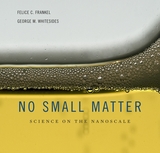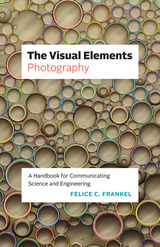
A small revolution is remaking the world. The only problem is, we can’t see it. This book uses dazzling images and evocative descriptions to reveal the virtually invisible realities and possibilities of nanoscience. An introduction to the science and technology of small things, No Small Matter explains science on the nanoscale.
Authors Felice C. Frankel and George M. Whitesides offer an overview of recent scientific advances that have given us our ever-shrinking microtechnology—for instance, an information processor connected by wires only 1,000 atoms wide. They describe the new methods used to study nanostructures, suggest ways of understanding their often bizarre behavior, and outline their uses in technology. This book explains the various means of making nanostructures and speculates about their importance for critical developments in information processing, computation, biomedicine, and other areas.
No Small Matter considers both the benefits and the risks of nano/microtechnology—from the potential of quantum computers and single-molecule genomic sequencers to the concerns about self-replicating nanosystems. By making the practical and probable realities of nanoscience as comprehensible and clear as possible, the book provides a unique vision of work at the very boundaries of modern science.


In this short handbook, award-winning science communicator Felice C. Frankel offers a quick guide for scientists and engineers who want to share—and better understand—their research by designing compelling graphics for journal submissions, grant applications, presentations, and posters. Like all the books in the Visual Elements series, this handbook is also a training tool for researchers. Distilling her celebrated books and courses to the essentials, Frankel shows scientists and engineers, from students to primary investigators, the importance of thinking visually. This crucial volume in the Visual Elements series offers a wealth of engaging design examples. Case studies and advice from designers at prestigious publications and researchers’ own before-and-after examples show how even the smallest changes—to color, type, composition, and layering—can greatly improve communication. Ideal for researchers who want a foothold for presenting and preparing their work for everything from conferences to publications, the book explains the steps for creating a concise and communicative graphic to highlight the most important aspects of research—and to clarify researchers’ own thinking. The resulting book is an essential element of any scientist’s, engineer’s, or designer’s library.

Award-winning photographer Felice C. Frankel, whose work has graced the covers of Science, Nature,and Scientific American, among other publications, offers a quick guide for scientists and engineers who want to communicate—and better understand—their research by creating compelling photographs. Like all the books in the Visual Elements series, this short guide uses engaging examples to train researchers to learn visual communication. Distilling her celebrated books and courses to the essentials, Frankel shows scientists and engineers the importance of thinking visually. When she creates stunning images of scientific phenomena, she is not only interested in helping researchers to convey understanding to others in their research community or to gain media attention, but also in making these experts themselves “look longer” to understand more fully. Ideal for researchers who want a foothold for presenting and preparing their work for conferences, journal publications, and funding agencies, the book explains four tools that all readers can use—a phone, a camera, a scanner, and a microscope—and then offers important advice on composition and image manipulation ethics. The Visual Elements—Photography is an essential element in any scientist’s, engineer’s, or photographer’s library.
READERS
Browse our collection.
PUBLISHERS
See BiblioVault's publisher services.
STUDENT SERVICES
Files for college accessibility offices.
UChicago Accessibility Resources
home | accessibility | search | about | contact us
BiblioVault ® 2001 - 2024
The University of Chicago Press









